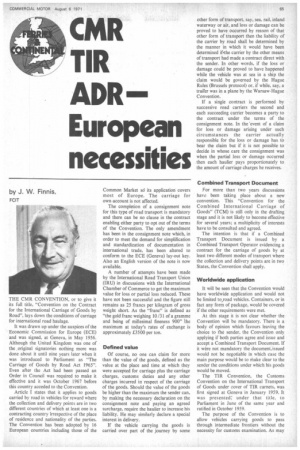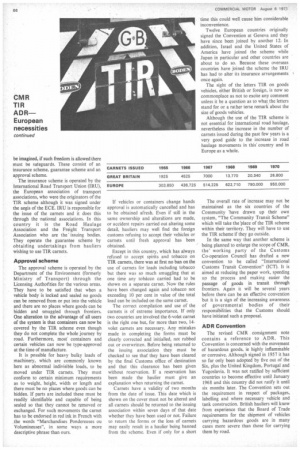CMR TIR ADR European necessities
Page 67

Page 68

If you've noticed an error in this article please click here to report it so we can fix it.
THE CMR CONVENTION, or to give it its full title, "Convention on the Contract for the International Carriage of Goods by Road", lays down the conditions of carriage for international road haulage.
It was drawn up under the auspices of the Economic Commission for Europe (ECE) and was signed, at Geneva, in May 1956. Although the United Kingdom was one of the . original signatories nothing more was done about it until nine years later when it was introduced to Parliament as "The Carriage of Goods by Road Act 1965". Even after the Act had been passed an Order in Council was required to make it effective and it was October 1967 before this country acceded to the Convention.
Article I states that it applies to goods carried by road in vehicles for reward where the collection and delivery points are in two different countries of which at least one is a contracting country irrespective of the place of residence and nationality of the parties. The Convention has been adopted by 16 European countries including those of the Common Market sd its application covers most of Europe. The carriage for own-account is not affected.
The completion of a consignment note for this type of road transport is mandatory and there can be no clause in the contract enabling either party to opt out of the terms of the Convention. The only amendment has been in the consignment note which, in order to meet the demand for simplification and standardization of documentation in international trade, has been altered to conform to the ECE (Geneva) lay-out key. Also an English version of the note is now available.
A number of attempts have been made by the International Road Transport Union (IRU) in discussions with the International Chamber of Commerce to get the maximum value for loss or partial loss reduced. These have not been successful and the figure still remains as 25 francs per kilogram of gross weight short. As the "franc" is defined as "the gold franc weighing 10/31 of a gramme and being of millesimal fineness 900" the maximum at today's rates of exchange is approximately £3500 per ton.
Defined value Of course, no one can claim for more than the value of the goods, defined as the value at the place and time at which they were accepted for carriage plus the carriage charges, customs duties and any other charges incurred in respect of the carriage of the goods. Should the value of the goods be higher than the maximum the sender can, by making the necessary declaration on the consignment note and paying an agreed surcharge, require the haulier to increase his liability. He may similarly declare a special interest in delivery.
If the vehicle carrying the goods is carried over part of the journey by some other form of transport, say, sea, rail, inland waterway or air, and loss or damage can be proved to have occurred by reason of that other form of transport then the liability of the carrier by road shall be determined by the manner in which it would have been determined if.the carrier by the other means of transport had made a contract direct with the sender. In other words, if the loss or damage could be proved to have happened white the vehicle was at sea in a ship the claim would be governed by the Hague Rules (Brussels protocol) or, if while, say, a trailer was in a plane by the Warsaw-Hague Convention.
If a single contract is performed by successive road carriers the second and each succeeding carrier becomes a party to the contract under the terms of the consignment note. In the 'event of a claim for loss or damage arising under such circumstances the carrier actually responsible for the loss or damage has to bear the claim but if it is not possible to decide in whose care the consignment was when the partial loss or damage occurred then each haulier pays proportionately to the amount of carriage charges he receives.
Combined Transport Document
For more than two years discussions have been taking place about a new convention. This "Convention for the Combined International Carriage of Goods" (TCM) is still only in the drafting stage and it is not likely to become effective for several years; a multiplicity of interests have to be consulted and agreed.
The intention is that if a Combined Transport Document is issued by a Combined Transport Operator evidencing a contract for the carriage of' goods by at least two different modes of transport where the collection and delivery points are in two States, the Convention shall apply.
Worldwide application It will be seen that the Convention would have worldwide application and would not be limited to,road vehicles. Containers, or in fact any form of package, would be covered if the other requirements were met.
At this stage it is not clear whether the Convention will be mandatory. There is a body of opinion which favours leaving the choice to the sender, the Convention only applying if both parties agree and issue and accept a Combined Transport Document. If it were not mandatory the document issued would not be negotiable in which case the main purpose would be to Make clear to the sender the conditions under which his goods would be moved.
The TIR Convention, the Customs Convention on the International Transport of Goods under cover of TIR carnets, was first signed at Geneva in January 1959. It was presented; under that title, to Parliament in June of the same year and ratified in October 1959.
The purpose of the Convention is to allow vehicles carrying goods to pass through intermediate frontiers without the necessity for customs examination. As may time this could well cause him considerable inconvenience.
Twelve European countries originally signed the Convention at Geneva and they have since been joined by another 12. In addition, Israel and the United States of America have joined the scheme while Japan in particular and other countries are about to do so. Because these overseas countries have joined the scheme the TRU has had to alter its insurance arrangements once again.
The sight of the letters TIR on goods vehicles, either British or foreign, is now so commonplace as not to excite any comment unless it be a question as to what, the letters stand for or a rather terse remark about the size of goods vehicles.
Although the use of the TIR scheme is not essential for international road haulage, nevertheless the increase in the number of carnets issued during the past few years is a very good guide to the increase in road haulage movements in this country and in Europe as a whole.




























































































































